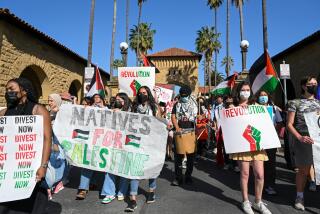In Seattle, the Lesson Is Inspirational
- Share via
SEATTLE — The general appeared before his troops--skinny, hairless, straining to talk above a murmur--but it didn’t matter. The troops exploded in cheers anyway, and the brass band played, and the choir sang, and more than a few wiped back tears.
John Stanford, the former Army general whose three-year tenure as Seattle schools superintendent has helped renew this city’s faith in urban schools, slipped out of the hospital last week where he has been fighting the battle of his life, with leukemia.
A downtown rally to kick off the school year was suddenly transformed as Stanford, scheduled to deliver a telephone broadcast from his hospital bed, instead stepped out onto the speaker’s balcony in person--just three weeks after a bone marrow transplant and two brutal but unsuccessful rounds of chemotherapy--and raised a weak fist in the air.
Students cheered. Teachers wept. That a thin bald man in a black baseball cap could ignite pandemonium in a downtown shopping district says much about Stanford, whose battle for his life over the last few months has come to symbolize the campaign he has waged to transform the public schools.
Faced with growing middle-class flight to suburban schools, declining test scores and a widening learning gap that was threatening to drop minority students out the bottom, Seattle hired the U.S. Army logistics officer in the hope that a general could succeed where a long parade of bureaucrats had failed.
Stanford immediately injected a note of brash optimism, changing the schools’ motto from “Every student can learn” to “Every student will learn.” He endowed principals with nearly complete authority over their schools and fired them if they didn’t make them work. He ended racial busing, demanded exit exams and pledged to fail students who didn’t pass them. He ordered parents to read to their children 30 minutes a day.
“I’ll fight for your kids until hell freezes over. Then I’ll fight on the ice,” Stanford told one Seattle church gathering shortly after coming to town.
But it was his boisterous, barrel-chested presence that was Stanford’s biggest imprint on the students and teachers around him; in the occasionally drab world of curriculum review committees and parent-teacher conferences and high school geometry classrooms, Stanford would stride in at a half-run, grabbing hands, picking up trash, taking stairs two at a time. “Perfect and improving,” he’d shout whenever anyone thought to ask how he was.
Then, in the middle of the last school year, the leukemia was diagnosed. Stanford went in for a round of chemotherapy in April, came out in triumph and went back to work. Then he was hospitalized for another round in June. When that failed as well, he entered the hospital for a third time three weeks ago, receiving transplanted bone marrow donated by an older sister.
Doctors have put his chance of a successful recovery at between 1 in 4 and 1 in 5. He isn’t scheduled to be released from the hospital for at least another week.
For last week’s back-to-school rally, school officials pledged to try to hook up a telephone link with Stanford, permitting the ailing superintendent to broadcast a message from his hospital bed. Instead, Stanford himself strode out onto the balcony, raising his hands pope-like to the throngs gathered below and sounding much like the old Stanford, with the volume turned down.
“This rally is about a world-class, student-focused learning system!” Stanford declared. “This rally is not about having 25% of the parents on board, concerned with the children. This rally is about having 100% of the parents on board. This rally is about asking parents right now, ‘Do you have a place set up in your home, away from the television set, where your children can do their homework?’
“This rally is about the business community. Look at these beautiful buildings around us, the nice sidewalks, the beautiful plantings. How could our children go into buildings to learn that are less capable than these buildings?”
Surveying the crowd below, Stanford said finally: “We all have created three wonderful years of growth. We can reminisce about that. But it’s time to get about rededicating ourselves, rededicating ourselves to doing more, to doing better--not to give up on each other, and never, ever give up on a child.”
In the sun-washed plaza below, teachers and administrators waved placards that said things like “Do Your Homework” and wore hundreds of T-shirts with the motto, “We won’t settle for less than 100%.”
“He shines through,” said elementary school counselor Marion Howard, trying to explain Stanford’s effect. “He has the ability, the light, to shine through and get us all involved and enthusiastic. When he talks to you, he talks to you. Everybody else is gone.”
“What is different about him is his incredible charisma, how the kids know and love and respect him,” added Dee Dee Rainbow, a retired middle-school teacher. “Everybody always talks about kids not respecting these days, but the kids know and respect him, and that’s the greatest thing you can say.”
She clutched a picture of Stanford, bald and ailing, that she wears on a string around her neck. “I’ve never prayed so hard for anybody.”
More to Read
Sign up for Essential California
The most important California stories and recommendations in your inbox every morning.
You may occasionally receive promotional content from the Los Angeles Times.













